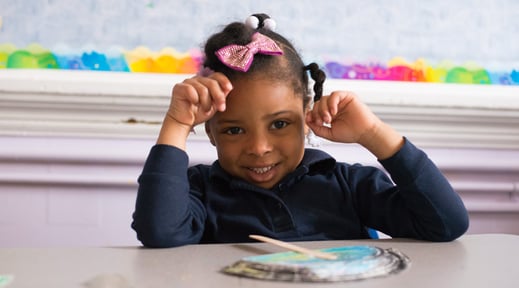
A couple weeks ago, a friend shared this short video below from The Atlantic with me. Turns out, this video was everything I love about good media: it was concise, included simple takeaways, and gave me something to think about (long after the video ended).
Like many of you, when I watch anything related to interacting with children, my mind goes right to CLASS. I couldn’t help but re-watch the video, slotting each of its “three rules for raising creative children” into effective teaching practices as the CLASS describes them.
While this video was created with parents in mind, I think it’s equally powerful for teachers. After all, as the video says, “conformity is dangerous,” and children are more likely to grow up to be Nobel Prize winning scientists if they grow up to be creative people! Why not incorporate these rules—and a little extra CLASS while you’re at it?!
Rule #1: Focus On Values over Rules
This concept is all about teaching children to think for themselves, rather than learning to obey rules just to “please adults.” Help children think about problems from a new perspective.
Apply this rule to the classroom:
Consider this scenario. During circle time, you are reading a book to the children. One child, Destiny, keeps creeping up closer to see the pictures, obstructing the views of other children. You might say something like, “Sit back down in your place on the carpet.” And she might obey.
Alternatively, you might take the opportunity to have a conversation with her around what happens when she creeps up to the book. How does this affect the other children? If the problem is that she cannot see from where she is sitting, how might this problem be resolved without making it hard for others to see the book, too?
What does this have to do with CLASS?
If you can facilitate a conversation like this with children—using thought-provoking questions to encourage problem solving—you are probably also incorporating Concept Development into the interaction. You also get “bonus points” for Regard for Student Perspectives by showing flexibility in following Destiny’s lead and eliciting her ideas.
Rule #2: Praise Character over Behavior
This rule is about acknowledging and reinforcing children for the people they are, rather than defining them by their behaviors. The video asserts that when you praise a child’s character, “they internalize it as part of their identities, and want to be creative again.”
Apply this rule to the classroom:
Picture this. During center time you play music in the background. The "Hokey Pokey" comes on, and a couple kids get excited and start using various toys (play pots and pans, a box of puzzle pieces, blocks) as percussion instruments, tapping to the beat and making different noises to accompany the song. You might say, “Good job!”
However, you could apply this rule by saying, “You are big thinkers, turning those toys into musical instruments!”
What does this have to do with CLASS?
By turning “good job” (vague praise) into a specific acknowledgement of what the children are doing, you’ve just practiced Quality of Feedback.
Rule #3: Use Lessons from Books
I love this rule. Maybe I like it so much because the narrator references Harry Potter in his description, but seriously, the point here is that by relating children’s book characters to real world situations and encouraging children to consider what a character might do, you can encourage creative thinking and empathy-building.
Apply this rule to the classroom:
Consider this situation. You are eating lunch with children and having a conversation about going to the doctor, when one child says he “does not like the doctor because he gives me shots.” You might respond, “Everyone needs to go to the doctor to have healthy bodies.”
On the other hand, you could take this opportunity to say something like, “Remember when we read Curious George this morning? What would happen if George had to go to the doctor? How would he feel?”
What does this have to do with CLASS?
Mealtimes are always great opportunities for incorporating effective interactions, and this example is no different. First, by encouraging discussions and asking open-ended questions, you are using Language Modeling. The conversation is also a good opportunity for including Concept Development as you integrate a character from a story with the real-world event of going to the doctor. And finally, by eliciting the child’s opinion, you are showing Regard for Student Perspectives.
Did this video inspire you as much as it inspired me? What do you do to foster creativity in the children you interact with?
